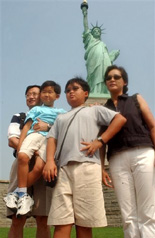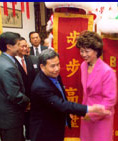|
|
|
 |
|
|
U.S.
Society > Asian-Americans |
|
The Statue of Liberty began lighting the way for new arrivals at a time when many native-born Americans began to worry that the country was admitting too many immigrants. Some citizens feared that their culture was being threatened or that they would lose jobs to newcomers willing to accept low wages. In 1924 Congress passed the Johnson-Reed Immigration Act. For the first time, the United States set limits on how many people from each country it would admit. The number of people allowed to emigrate from a given country each year was based on the number of people from that country already living in the United States. As a result, immigration patterns over the next 40 years reflected the existing immigrant population, mostly Europeans and North Americans. Prior to 1924, U.S. laws specifically excluded Asian immigrants. People in the American West feared that the Chinese and other Asians would take away jobs, and racial prejudice against people with Asian features was widespread. The law that kept out Chinese immigrants was repealed in 1943, and legislation passed in 1952 allows people of all races to become U.S. citizens. Today Asian Americans are one of the fastest-growing ethnic groups in the country. About 15 million people of Asian descent live in the United States. Although most of them have arrived here recently, they are among the most successful of all immigrant groups. They have a higher income than many other ethnic groups, and large numbers of their children study at the best American universities.
Chinese
Largest Asian Group in the United States |
||||
| Texts
are abridged from U.S. State Department IIP
publications and other U.S. government materials. |
||||
| Feature Articles | ||||
Graphic
Novels
- Drawing the Asian-American Experience From
Philosophy to Food, Asian Culture Inspires Americans Asian
Pacific American Heritage Month a Celebration of Diversity U.S.
Minority Population Continues to Grow. By David Minckler |
||||
DISCLAIMER
Any reference obtained from this server to a specific commercial product, process, or service does not constitute or imply an endorsement by the United States Government of the product, process, or service, or its producer or provider. The views and opinions expressed in any referenced document do not necessarily state or reflect those of the United States Government. |
 U.S. Diplomatic Mission to Germany /Public Affairs/ Information Resource Centers Updated: October 2010 |

